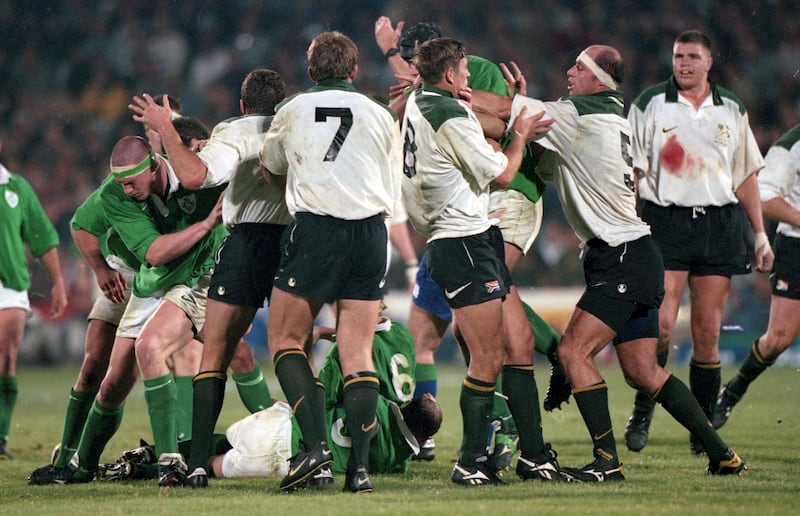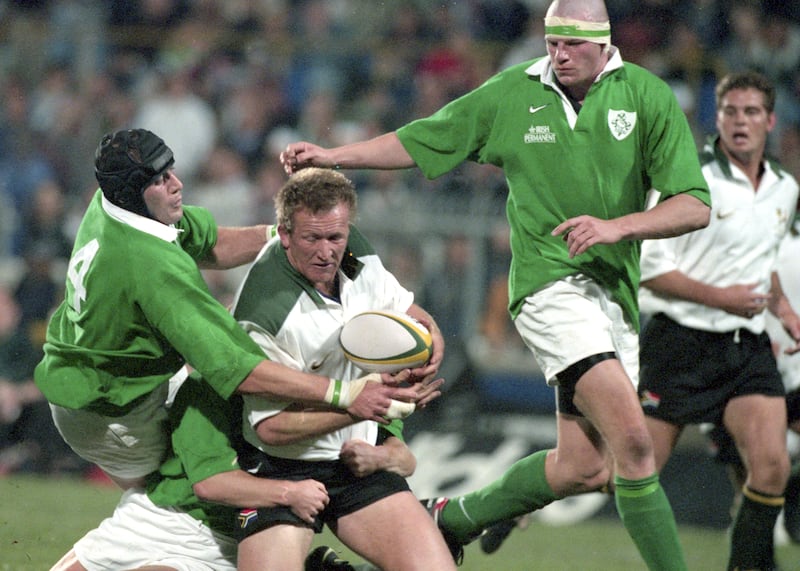South African centre Damian de Allende promised that Saturday’s clash with Ireland in Pretoria would be “almost like a war.” If he wants to see rugby quite literally turning into hand-to-hand combat, he need look no further than back to the last time Ireland played at Loftus Versfeld.
It’s easy to forget how quickly rugby has changed as the sport became more professional. Any old footage, even from only a few years ago, offers a stark contrast to the game before us today. Regardless of the anticipated nostalgia, few examples provoke as much shock as the highlights of Ireland’s last trek to South Africa’s capital, a 33-0 shellacking at the hands of the Springboks.
In just the 13th minute, Ireland lock Malcolm O’Kelly found himself falling to the floor while wading through a maul. To say that South Africa’s scrumhalf, Joost van der Westhuizen, was frustrated at having his path to the ball blocked by the then 23-year-old Tempelogue man, would be an understatement.
Van der Westhuizen took no time at all in planting one of his size 10s into O’Kelly’s back. French referee Joel Dume had clear sight of the kick. None of today’s penchant for a lengthy chat with the assistant referees or the TMO, out came the card. Yellow. No prizes for guessing the colour that would be brandished in today’s game.
That would be the last of the cards, but not the violence. Springbok captain Gary Teichmann later said that he was proud of how his team handled themselves that day. “Often we were provoked,” he said on a SuperSport documentary detailing that 1998 tour. “But we didn’t retaliate too badly.”
Let’s generously say that Teichmann’s memory is a tad selective. Such was the sheer lack of regard for personal safety on both sides, the YouTube highlights of the game are age restricted.
In that match, Springbok hooker James Dalton didn’t take too kindly to a shoulder in the back from Irish number eight Victor Costello. Cue punches on both sides and an almighty fracas on the floor.
Teichmann himself later didn’t appreciate Kevin Maggs’ decision to hold onto his shirt as the pair chased a loose ball. A swinging, retaliatory elbow failed to make contact with Maggs’ head, but it did start another rumble.
By the time Trevor Brennan, fresh off the bench, took aim at one Johan ‘Rassie’ Erasmus, brawls had long become the game’s norm. Paddy Johns, the Irish captain, was front and centre of this particular coming together, trading haymakers with South Africa’s Krynauw Otto.
The Sky Sports commentator was, quite frankly, disgusted. He laid plenty of the blame for the game’s behaviour at the feet of Johns, who “should be substituted before he gets sent off.” Given Monsieur Dume hadn’t given anyone their marching orders by this stage, anything and everything seemed fair game.

“Every time there’s a tackle-ball situation, there are punches and kicks coming in,” continued the commentator. He was only being slightly hyperbolic.
The final blow, again, quite literally, came when poor old South African debutant, McNeil Hendricks, was unceremoniously dumped on his back off the ball by an Irish substitute. It’s safe to say the laws around lifting a player beyond the horizontal in a tackle were not a concern back then.
Ireland could well have had a debutant of their own in Gordon D’Arcy that day had he not turned down a call-up from Warren Gatland. In order to avoid having to repeat the exams, D’Arcy opted to stay in Clongowes Wood College and sit his Leaving Cert instead of travelling to South Africa. Academically, he probably made the right choice. Physically too, given no schoolboy was likely to survive that Battle of Pretoria.
Violence aside, tries from van der Westhuizen, Erasmus, Dalton, Teichmann and Pieter Rossouw, combined with a stuttering Irish attack, handed South Africa a comfortable win. No Test match between the two sides at the altitude of Loftus took has taken place since.

Not that the ground has been devoid of Irish visitors. Its status as a graveyard for Ireland’s ambitions has remained largely intact. Leinster recently had their season ended in Pretoria by the Bulls in the URC semi-finals. Last year, a largely second-string outfit was handed a 62-7 shellacking by the same opposition.
Munster’s April win over the Bulls on their travels was a rare bright spot for Irish rugby at Loftus. Even on Lions Tours, Irish fortunes have been poor. In 2009, the second Test took place in Pretoria. Aided by the altitude, Morne Steyn infamously slotted a late, series-winning kick after Ronan O’Gara’s chip and chase led to a penalty which has gone down in Lions lore for the wrong reasons.
Saturday will see Ireland aim to write a rare positive chapter in this history. The game will undoubtedly see violence, but of an altogether different kind to what we witnessed 26 years ago.
- Sign up for Sport push alerts and have the best news, analysis and comment delivered directly to your phone















